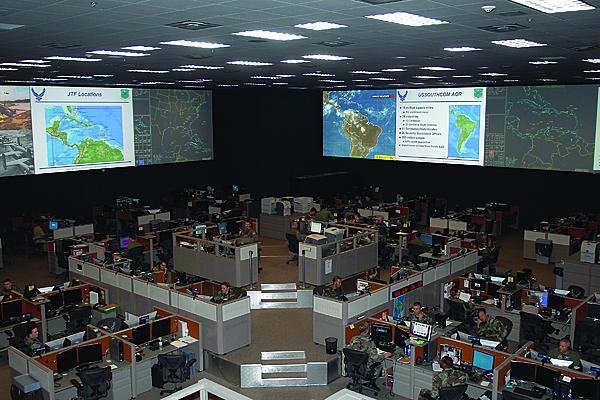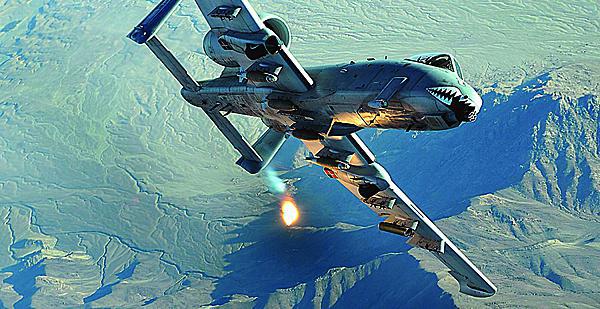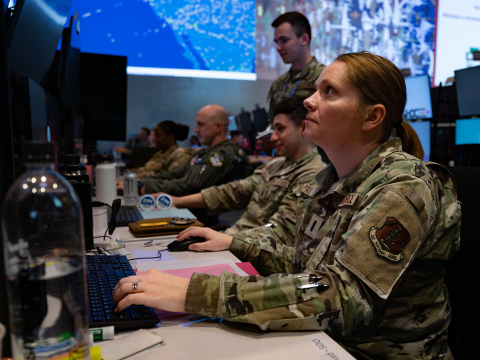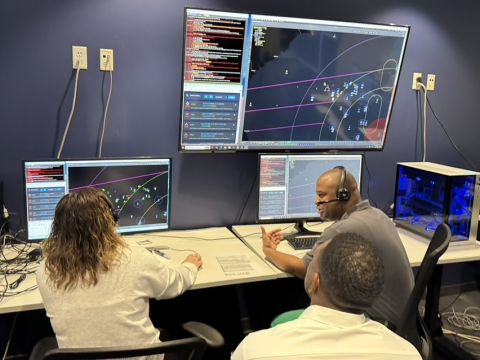Crown Jewel Program Modernizes Air Operations
A critical U.S. Air Force program designed to refurbish the service’s operations centers around the world likely will begin by upgrading the first site next year. The potential $504 million effort will automate services, improve interoperability, speed decision making, enhance cybersecurity and lower costs.
Air operations centers are the command and control centers for planning, executing and assessing joint air operations during a contingency or conflict. They support joint force air component commanders in planning and executing missions.
Those centers have been equipped with an operational baseline known as 10.1. With 10.2, the Air Operations Center Weapon System (AOC WS) modernization program is poised to better integrate data from more than 45 systems and applications that feed data into the centers. The upcoming improvements will facilitate machine-to-machine data transfer, allowing commanders to make decisions more quickly while reducing human error.
Lt. Col. Kyle Reybitz, USAF, AOC WS program manager, paints a somewhat hectic picture of contemporary AOCs. Because the various systems are not fully integrated, people call out to request targeting data, or they hand-deliver data. “Our putting together a common infrastructure allows these systems to be better integrated and share the data more securely. Ultimately, that results in speed of command. We get data in there; we can process it much faster; and we can have quicker actual plans on the battlefield as determined by the joint forces air combat commander,” Col. Reybitz states.
The AOC WS modernization program achieved milestone B approval and moved into the engineering, manufacturing and development phase in October 2013. It was scheduled for a critical design review in March. The program, which is gliding toward an initial operating capability in fiscal year 2016 and full operational capability the following year, will affect seven regional centers around the world, including AOCs for Southern Command, Central Command and Pacific Command.
The modernization effort also will involve two support sites—a help desk at Joint Base Langley-Eustis, Virginia, and a formal training unit at Hurlburt Field, Florida. A site within the continental United States likely will be the first to receive 10.2 for practical reasons. “There hasn’t been a determination yet what will be the first site in 2015. We’re in discussions. It’s really Air Combat Command’s decision. We’ve talked about potentially one of our continental U.S. sites, just for ease of troubleshooting and resolving any issues we might have. And it saves us money on travel,” he reports.
The modernization program also will accelerate the integration of third-party systems. The program office and prime contractor Northrop Grumman have built two capabilities not existent in the current 10.1 baseline. The first is an assistance environment for developers, which already has hundreds of users. “That’s accessible online for third-party developers to go on, test their code, grow familiar with the services and procedures we have in place and really get involved,” Col. Reybitz reports.
The other is a next-level integration test laboratory (ITL), which already has been instrumental in automating one of the more complex tasks within an AOC. “The ITL takes it up a notch for actually sharing services and capability in a more operational environment in our facilities inside Langley Air Force Base,” the colonel explains.
Col. Reybitz lists reduced costs as another primary benefit of the program. “We reduce the warfighters’ ownership costs by providing a common infrastructure for these third-party systems. Instead of these systems needing to provide their own backbone, or their own data services, we provide that as a core infrastructure service and then savings get passed on to the warfighter. It’s nothing we do directly. It’s the second- or third- order effects of what we’re doing,” he explains.
Additionally, the program will improve cybersecurity. “Without going into too much detail, it really has been a pickup game on 10.1, and we secured the components the best we can. A lot of them are one-off systems that require their own certification process. By bringing everybody under the umbrella of a secure architecture and applying scans and lockdowns and getting the entire system certified, we’re better able to manage and secure the information assets that we have,” the colonel offers.
Benefits largely derive from automating 16 core mission threads. “The one that we’ve been focused on, due to its complexity and the bigger third-party systems that we integrate, is the dynamic targeting mission thread. Not all mission threads are created equal,” Col. Reybitz allows. “We, up to now, have shown significant process in the development of the automation of this mission thread. That’s been demonstrated.”
Now the program office is turning its attention to the combat search and rescue and “adjust air space” mission threads. “Search and rescue is a high-priority effort, and adjusting the airspace, controlling the airspace, at any major theater is quite the challenge,” he declares. “The plan is to eventually automate all 16 mission threads.” The mission threads can vary from one site to another, he adds.
The program is on schedule, but any effort of this size and magnitude experiences some turbulence in the form of challenges. For example, many of the systems that feed data into the AOCs are owned by others and have their own schedules to meet. The Defense Information Systems Agency (DISA) is “a major player” that manages the Global Command and Control System-Joint and “produces a lot of the information used by other third-party systems across the AOC,” the colonel says. In addition, the Joint Automated Deep Operation Coordination System is an Army program. The colonel says that “a good chunk” of the systems are managed by the Air Force, but a significant number are managed by the other services and DISA. “It’s these third-party programs that we need to bring together that aren’t beholden to our schedule. The fact of the matter is, we don’t own these systems. It’s tricky being a third-party integrator,” Col. Reybitz adds.
Modernization also includes programs still in the laboratory. Furthermore, the AOC WS team has partnered with the Navy to leverage work being done on the Consolidated Afloat Networks and Enterprise Services (CANES) program (SIGNAL Magazine, February 2014, page 30, “Full Steam Ahead ...”), he reports. “We have a significant partnership with the Navy utilizing their agile core services, a separately managed project under CANES. They put in their common set of services, the agile core services, and we are completely leveraging that capability for the Air Force.”
He stresses the importance of strong relationships for integrating third-party programs. “That’s the largest remaining challenge we have. That’s going to be continual. That’s just the nature of our business,” Col. Reybitz points out.
Modernizing the AOCs unofficially began in the early 2000s, the colonel explains. “We started putting all these computer systems together in the same room, some of them integrated, some of them not, basically modifying all sorts of code and systems to get the information to support the joint tasking order concept,” he says.
The 10.2 effort began “officially spending money” in 2007. The program initially came up for a milestone B approval in 2010, but the Office of the Secretary of Defense suggested it go through an additional risk reduction effort. Legislation requires programs to report to Congress if they are unable to field a capability within five years, and the AOC WS team did that last year. “We went through a complete revalidation of our requirements, new cost estimates and all that during sequestration. The Air Force decided to make this a priority acquisition program and to commit to funding and basically revalidated all the requirements to include officially stating that it’s essential to national security,” he recalls. “We call it a crown jewel program. It provides tangible improvements to the warfighter and to our capability to prosecute the air battle in any theater.”






Comments